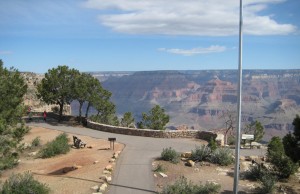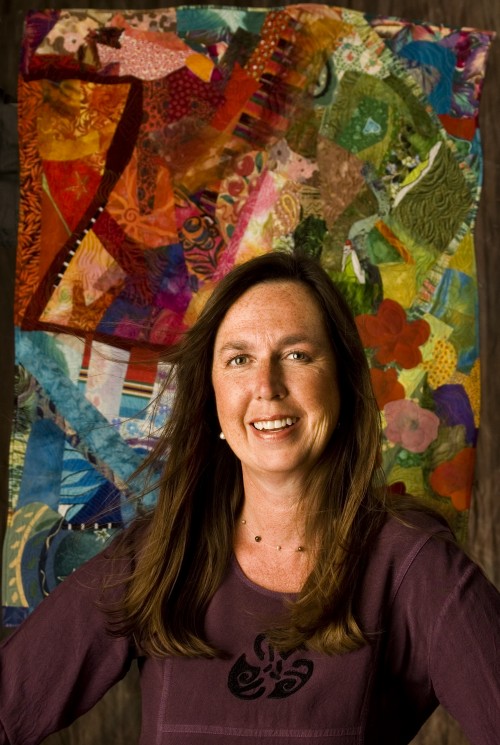 My friend, René, is on her way to Oregon, where her husband has a new job. I met René years ago in a workshop. She handed me her card: “René Westbrook: Gluing Things to Stuff Since 1989.” I laughed, and knew immediately that I wanted to be her friend. After living at the South Rim of Grand Canyon for 11 years, she moved to Flagstaff so her daughter could attend high school at Flagstaff Arts and Leadership Academy. Lucky me.
My friend, René, is on her way to Oregon, where her husband has a new job. I met René years ago in a workshop. She handed me her card: “René Westbrook: Gluing Things to Stuff Since 1989.” I laughed, and knew immediately that I wanted to be her friend. After living at the South Rim of Grand Canyon for 11 years, she moved to Flagstaff so her daughter could attend high school at Flagstaff Arts and Leadership Academy. Lucky me.
During the time she lived here, we showed our artwork together, and met sporadically for lunch, studio visits and cocktails (not necessarily in that order). She invited me to the South Rim to meet artists, take workshops and just hang out. She’s been an inspiration to me as both an artist and as an advocate for the arts.
In 2009, René became the coordinator for the newly-formed Artist In Residence (AIR) program at Grand Canyon National Park’s South Rim. In six years—and on a shoestring budget—she built the program into one of the most innovative and well-respected national park AIR programs in the U.S., working tirelessly, and always with great enthusiasm, generosity and graciousness. I somehow doubt that any of us know exactly how much good she did for the arts during her tenure.
I do know this: she did an extraordinary job of bringing in a diverse group of artists, not just landscape painters, but sound artists, jewelers, printmakers, musicians, instrument builders, videographers and more.
Part of her skill in administering the program was in pulling together the jury panel. Panel members review applications sent by hundreds of artists vying for only a handful of slots. The diversity of the applications makes it challenging to select the right mix of artists, but also makes jury selection critical. René pressed visual artists, musicians, graphic designers, administrators and others into service, and helped them understand what they were looking at when it wasn’t always obvious.
Landscape painters, take no offense, but there’s far more to recording and interpreting a landscape than portraying it in a literal way. That is part of the beauty of the South Rim’s AIR program: René helped the park envision a progressive model, allowing for a more expansive and innovative approach.
When I look today at one of Gunnar Widforss’s watercolors from 90 years ago, I understand it as an interpretation of Grand Canyon and, whether Widforss meant it this way or not, a postcard to the future. He was painting something that hadn’t been widely seen. And let’s face it: if it weren’t for those early painters and writers, the National Park System likely wouldn’t exist.
But all over the world artists are developing new ways of communicating about place, and many of them have brought those new ideas to bear on Grand Canyon through the park’s AIR program. What they’re doing isn’t obvious to the rest of us; we may not understand these artworks until 100 years from now.
In 2012 Shawn Skabelund’s artwork, The Price of Admission, was exhibited at Grand Canyon National Park headquarters. This site-specific, place-based installation addressing the history, facts and politics of uranium mining within the park was created after Skabelund’s residency at the park in 2011. In spite of the project’s controversial nature, park administrators and Skabelund found ways to work together to present a powerful piece of artwork to the visiting public.
Skabelund writes, “For me, a key value of being an AIR is a ‘clearing,’ an open space, where one is allowed to have a dialogue in and with a new environment … Without residencies and the possibility of sharing the ‘other,’ communities become stagnant. That is what made the South Rim AIR so much more and different than other national park AIRs. René brought in artists exploring topical, contemporary concerns, both formally and conceptually. The role of the artists is to educate themselves and the viewer by searching for truth using new forms and concepts, and that is what viable AIR programs push toward.”
Bonnie Peterson, a Michigan textile artist who’s done a number of residencies over the course of her career, appreciates having special research access to libraries, photo collections, staff, etc. “These resources are not always open to the public and even if they are, it takes time to arrange their viewing, which a residency allows,” she says. She also finds that residencies offer her “a connection to a place that fosters many years of ideas and artwork about that place.”
Rachel Wilson was an AIR at GCNP in 2010, and feels that “residencies all share the wonderful virtue of giving the participants a breakout opportunity and complete change of routine coupled with the sense that their work is valued and appreciated. It is heady stuff.”
She also wrote, “How can you measure the value of an art experience …? It is part of having a civilized society. [Art] influences over time the people and culture it contacts in both overt and subtle ways, but to unknown ends. It is elusive in its basic nature.”
Rebecca Solnit, in her excellent book of essays, Men Explain Things to Me, writes about the “tyranny of the quantifiable,” which might be one of the most brilliant phrases I’ve heard recently.
Some things aren’t measurable, which doesn’t mean we should give up trying to fathom them. It’s OK—even desirable—to live with uncertainty, to leave space for mystery, even though uncertainty doesn’t generally play well in bureaucracies. Maybe in 100 years we’ll understand the value of those more complex and less traditional forms of art, but only if, like Widforss’s paintings, they’re in the archives.
Like Virginia Woolf’s proverbial room of one’s own, freedom and space are essential tools for doing good work. Residencies allow ideas to flow in like water, and give us time to lavish on those ideas.
Thanks, René, for helping make those rooms possible for so many of us.
Darcy Falk is a textile artist and writer who has made Flagstaff her home for almost 30 years. The best sign in her studio says, “Don’t Give Up,” and she takes that advice often. See more of her writing and artwork at www.darcyfalk.com.

